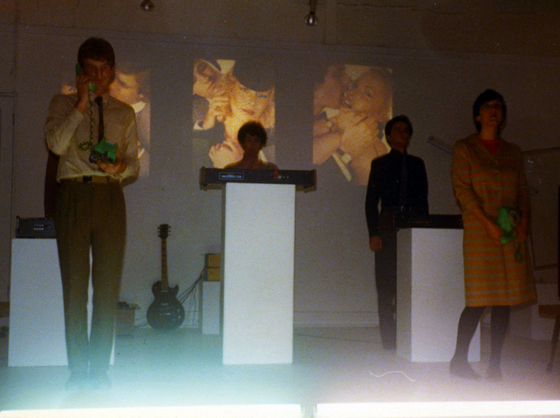"What is this thing called 'Disco'?"
Background
The Asphixiation project was a major set of integrated works devised by Philip Brophy for the group → ↑ → in 1980. Subtitled "What is this thing called 'Disco'?", its premiere manifestation was comprised of an installation, a performance, and a catalogue essay. Following the work's premiere, a record was released of the music from the performance, and a music-video was produced for the record.
Credits
Installation
Design - Philip Brophy
Paintings - Philip Brophy
Painting assistance – Maria Kozic, Leigh Parkhill, Jayne Stevenson, Ralph Traviato
Curators - Alecs Danko & Judy Annear
Music
Music composition, arrangement & production - Philip Brophy
Lyrics - Ralph Traviato
Vocals – Philip Brophy, Maria Kozic, Leigh Parkhill, Jayne Stevenson, Ralph Traviato
Guitars – Leigh Parkhill
Sax – Ralph Traviato
Drums & keyboards – Philip Brophy
Engineering - David Chesworth & Chris Wyatt
Performance
Direction, staging & slides - Philip Brophy
Performers - Philip Brophy, Maria Kozic, Leigh Parkhill, Jayne Stevenson, Ralph Traviato
1980
George Paton Gallery, Melbourne
Leigh Parkhill, Jayne Stevenson, Ralph Traviato & Maria Kozic - performance, George Paton Gallery, Melbourne © 1980Overview
"What is this thing called 'Disco'?"
In keeping with much of the work produced under the → ↑ → banner since 1977, the Asphixiation project was a material deconstruction of a linguistic phenomenon. Combined with the core cultural politique of → ↑ → which viewed all cultural produce equally worthy of complete annihilation and total celebration, this meant the 'disco' would be an inevitable topic for artistic investigation. Having predominantly worked in music, film and video, the invitation to exhibit in a contemporary art space elicited the simple query: what would be the last thing to put in a gallery? Disco inevitably reared its beautiful head. The installation is a clinical dissection not simply of 'disco' as a genre or style, but more so an exercise in forensically emptying something of its content to uncover that meaning will still reside in its shell.
The Asphixiation project thus grew and mutated quite logic: → ↑ → would 'become' a disco band and perform (miming, of course, like the best and truest Disco) and the gallery would be the textual space of such a procedeure. All sociological and anthropological values were cauterized in the gallery presentation. No comment was made on the audiences, the scenes, the subcultures; that was deemed the territory of music journalists, social theorists and 'pop culture analysts'. For Philip specifically and → ↑ → generally, the sound of Disco was enough of a world by itself - indeed, a more exciting and sensory world. The music was minimalist, electronic, technological, artificial, glamorous, unreal, heady, immersive, alienating, perverse and pop. It seemed to be greater than everything else which was making grand claims to change the world. Disco always stated itself with extreme clarity; it was solipsism made sonic. The Asphixiation installation was the space to hear this.
Leigh Parkhill, Jayne Stevenson, Maria Kozic & Ralph Traviato - performance, George Paton Gallery, Melbourne © 1980Technical
The George Paton Gallery (housed within the Student Union building of Melbourne University) was a contemporary art space consisting of 2 gallery spaces: one large open space, and one slightly smaller area strangely divided into 6 open cubicles, 3 on each side of a central open corridor. The space logistically ideal for the Asphixiation project: each 'room' was treated as a 'sonic zone' containing aural elements of Disco musical motifs contained separately in each space.
Each of the spaces visually was treated as one was 'window-dressing' a display of Disco (an idea in keeping with → ↑ →'s embrace of all Pop operations). A plinth held the actual musical instrument. Suspended in front of it was an angled suspended frame with clear film, allowing the visitor to look at the instrument both as a sculptural object and a framed painting. The strategy of course was disingenuous: the objects themselves were bluntly recontextualised as such, rather than seriously explored as bearing 'art' values. Each space was illuminated by a sole fluorescent light hung angled on an adjacent wall. Finally, a large painting was similarly hung at an angle on the connecting wall. Each painting - like every component in the exhibition - was not a painting per se, but a mere sign of a painting. The images were portraits of models from L'Uomo and Vogue, painted in hard-edge Pop-ist colours. Completely flat, expressionless, hyper-graphic, dumbly painted.
Philip Brophy, Maria Kozic, Leigh Parkhill, Jayne Stevenson & Ralph Traviato - performance, George Paton Gallery, Melbourne © 1980
















